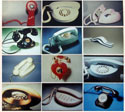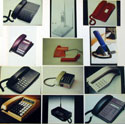| 


|
CHAPTER
3  pdf (468 Kb)
pdf (468 Kb)
In the contextual inquiry the role of existing designs in the generation
of new concepts was identified as ubiquitous and important, yet
not very well understood and supported. Being solutions to previous
problems, these precedents provide designers with important frames
of reference in the generation and development of new product forms.
Reflecting certain elements of convention, which have been developed
in a society in the relation between function, form and use of a
product, these precedents embody design knowledge which can be applied
by the designer in new design situations. However, because of the
unique and specific character of these situations in an ill-structured
problem domain such as design, the designer can not simply 'copy'
such knowledge from existing designs and 'paste' it into the design
task at hand. Thus successful transfer of design knowledge from
precedents would require some form of active adaptation by the designer.
How, then, does this adaptation process proceed, how can it be influenced
and in what way should a design support tool be organized to augment
it?
DISPLACEMENT OF CONCEPTS
As a first step in answering these questions, a framework to describe
the role of existing products in the generation and development
of new form concepts was constructed through a theoretical exposé
on the formation of new ideas. It was argued that these come about
through a ‘displacement of concepts’, a process in which
old concepts do not literally get transferred to new situations,
but are to be restructured in response to the characteristics of
the new situation.
CLASSIFICATION
By projecting the old concept onto the new situation, the old
would become a program for the exploration of the new, through which
aspects and qualities of new concepts can be envisioned and evaluated.
Classification plays a key role in this process, in that possible
candidates for displacement would manifest themselves as basic-level
concepts that can be distinguished in the existing structure of
the new situation. Projection of these basic-level concepts to either
a more general or more specific level of knowledge organization
would then induce the formation of new concepts.
FORM CREATION
This general framework was then made more specific for the form-creation
phase of the product design process. A special form of classification,
‘Typification’, was presented as a means to identify
and structure the design knowledge which products embody. By grouping
together products on their shared typicality regarding function,
form or meaning, product types are formed, in which the product-specific
knowledge of the individual instances is organized on a problem-independent
level. This specific character then affords the projection of these
types to new design situations. Three product typologies were developed
each representing a body of design knowledge on a different level
of organization. Throughout the form-creation phase the designer
then alternates between these levels, to identify relations between
forms, materials and functions of products, or between forms, materials
and socially and culturally determined uses of products. |



|
